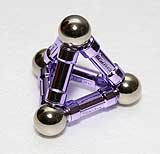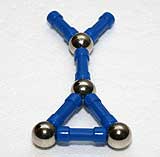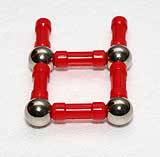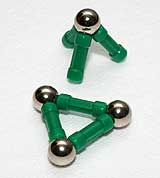|
Building polyhedra with Magnetix, part 1
|
Mega Brands' Magnetix system allows to build the skeletons of quite a few polyhedra using nothing more than the two most basic components of the system: balls and bars.  Since in the basic sets all bars have the same length, and since the angles between the vertices can be set to arbitrary values (as long as it's greater than a certain minimum value) Magnetix can be used to build polyhedra that can be impossible to build with other toys like Zome in which the angles are constrained to pre-defined values. Since in the basic sets all bars have the same length, and since the angles between the vertices can be set to arbitrary values (as long as it's greater than a certain minimum value) Magnetix can be used to build polyhedra that can be impossible to build with other toys like Zome in which the angles are constrained to pre-defined values.
On the other hand, since the angles aren't rigid, the only polygon that can be rigidly built with the basic components and without any additional bracing is the equilateral triangle. Based on my experience so far, all polyhedra that can be rigidly built with Magnetix appear to be either fully built with triangles or are built with some bracing (where the bracing  essentially builds triangles "inside" the polyhedron so that the outer shell can be built with non-triangular faces). That leads to defining a class of polyhedra that can be uniquely rigidly built with no explicit constraint on the angles between the edges, which I'll call "Magnetixhedra". essentially builds triangles "inside" the polyhedron so that the outer shell can be built with non-triangular faces). That leads to defining a class of polyhedra that can be uniquely rigidly built with no explicit constraint on the angles between the edges, which I'll call "Magnetixhedra".
Magnetix basic sets contain 3 bars for every 2 balls. That's why the part count of all the basic sets is a multiple of 5 (20, 35, 70, 150). That's exactly the ratio of parts needed to build tetrahedra (6 edges and 4 vertices). That's also the ratio needed in cubes (12 edges and 8 vertices) and in regular dodecahedra (30 edges and 20 vertices), but those aren't rigid, i.e. they aren't Magnetixhedra. Since all "normal" polyhedra have at least 3 edges for each vertex (those wouldn't be vertices otherwise), the ratio of 3 bars to 2 balls is quite optimistic and it's  quite obvious that Mega Brands has been cutting costs by including in fact many more balls than is actually useful, so that people trying to build rigid structures end up with many leftover balls. Based on my experience, a decent ratio is approximately 7 to 8 bars for every 3 balls, i.e. a set of 150 parts ends up with approximately 125 to 130 "effective" parts. Of course, the actual ratio varies from one model to another, and unless all you want to build are rows of tetrahedra you won't be able to use every single part in your sets. quite obvious that Mega Brands has been cutting costs by including in fact many more balls than is actually useful, so that people trying to build rigid structures end up with many leftover balls. Based on my experience, a decent ratio is approximately 7 to 8 bars for every 3 balls, i.e. a set of 150 parts ends up with approximately 125 to 130 "effective" parts. Of course, the actual ratio varies from one model to another, and unless all you want to build are rows of tetrahedra you won't be able to use every single part in your sets.
While Magnetix structures can be built reasonably quickly, they typically don't "last" very long. That's not because the toy is not durable (it is), but because Magnetix is quite expensive (I bought mine at a price that boils down to about 30 cents for each bar). The structures built in Magnetix can be replicated with other construction methods. One of those methods is to glue Q-tips together. As the cost of Q-tips is approximately 1% of the cost of Magnetix bars, it's a lot more cost-effective, but it also takes much longer to build and requires a bit more planning.
For everyone's safety, I want to remind people that there have been problems with Magnetix sets in the past. While the version currently being sold in stores is believed to be safe, people should still be careful when playing with Magnetix sets, especially in households with young children, Magnetix parts should be handled with caution and should be discarded if they start to crack or if magnets are loose, and missing magnets should be searched for. Of course, you should also be careful when buying used sets. The injuries that have occured when kids swallowed multiple powerful magnets were severe enough that I thought it was important to remind everyone to be careful.
All right, enough talking, let's build something. Let's get started with the simplest of all polyhedra, which happens to be a Magnetixhedron. Like we've noticed earlier, polyhedra whose sides are all  equilateral triangles are usually rigid when built with Magnetix. Let's get started with the polyhedron that is built out of 3 triangles, the tetrahedron (its full name is the regular tetrahedron, but it is commonly assumed that "the" tetrahedron is the regular one). It's possible to build the tetrahedron "randomly" with Magnetix: start with 4 balls and join them until all balls are joined to one another. It's also possible to build the tetrahedron with a mathod that will be scale up to some of the more advanced models, which uses the fact that a tetrahedron is a triangular pyramid, and in fact can be thought of as an augmented triangle. The method therefore follows these steps. (1) Build part 1, which is a triangle. (2) build part 2, which is made out of 3 bars attached to a ball. (3) join parts 1 and 2. I know that such instructions seem superfluous for a polyhedron as simple as a tetrahedron, but that technique will be useful as we work our way toward more complex models. equilateral triangles are usually rigid when built with Magnetix. Let's get started with the polyhedron that is built out of 3 triangles, the tetrahedron (its full name is the regular tetrahedron, but it is commonly assumed that "the" tetrahedron is the regular one). It's possible to build the tetrahedron "randomly" with Magnetix: start with 4 balls and join them until all balls are joined to one another. It's also possible to build the tetrahedron with a mathod that will be scale up to some of the more advanced models, which uses the fact that a tetrahedron is a triangular pyramid, and in fact can be thought of as an augmented triangle. The method therefore follows these steps. (1) Build part 1, which is a triangle. (2) build part 2, which is made out of 3 bars attached to a ball. (3) join parts 1 and 2. I know that such instructions seem superfluous for a polyhedron as simple as a tetrahedron, but that technique will be useful as we work our way toward more complex models.
|
|
Home page
|
Related articles
|
Posted on May 13 2007
|